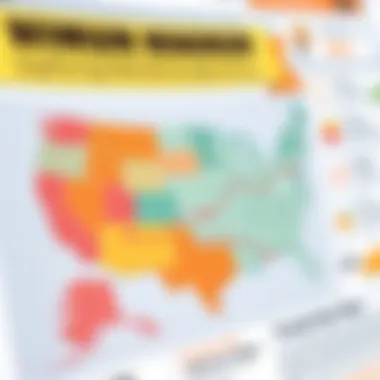States with the Highest Minimum Wage: Insights and Impacts


Intro
In recent years, minimum wage discussions have shifted from the fringes of economic debate to center stage in the public discourse. The idea that how much a worker earns impacts not just their livelihood but also the economy at large has gained traction among policymakers, analysts, and the general populace. This is especially true in states that have instituted higher minimum wage laws than the federal baseline. Here, we explore the varied landscape of minimum wage across the United States, focusing on those states that have taken the bold step of raising wages considerably above the federal mandate.
The Stakes are High
Higher minimum wages can lead to a debate filled with fervor. Proponents argue that raising the minimum wage provides workers with additional financial security, ultimately leading to a happier and more productive workforce. Critics often raise concerns about potential job losses and the effect on small businesses that might struggle to adapt to higher payroll costs.
To comprehend the overall implications, one must delve into how different states approach this crucial issue. This article will not only lay out the current minimum wage rates across states but also examine trends, implications, and the socio-economic factors that prompt these decisions.
As we navigate this complex terrain, we’ll also highlight important terminology and concepts, offering insights into the policies that shape minimum wage laws and their ripple effects on workers and businesses alike.
To add depth to our analysis, we’ll look ahead to potential changes in legislation, considering economic indicators and public sentiment. Guiding our readers through this overview will be a priority, ensuring a comprehensive understanding of why this issue matters now more than ever.
"Understanding minimum wage is not merely an academic exercise; it’s pivotal to grasping the economic realities facing millions of workers and employers across the nation."
As we embark on this examination of states with the highest minimum wages, let’s first analyze the key terminology that fuels this ongoing conversation.
Prelude to Minimum Wage
The concept of minimum wage is a cornerstone in discussions about labor rights and economic equity. It serves as a baseline that dictates the lowest amount of compensation employers can legally provide to their employees for work performed. This topic holds immense significance in today's society, influencing the lives of millions of workers while also shaping the operational frameworks of businesses across the nation.
The importance of minimum wage arises from its potential to lift individuals and families out of poverty, ensuring that even the most basic needs can be met. By setting a legal floor on wages, it aims to reduce wage discrimination and ensure fair pay for all workers. While some argue that minimum wage laws can lead to unintended consequences for employment rates, it’s essential to examine the broader impact these laws have on income inequality, living standards, and economic growth.
More than just a figure on a paycheck, the minimum wage is a reflection of societal values regarding labor and compensation. It signifies a commitment to providing a living wage, a topic that resonates deeply in discussions regarding social justice and economic policy. Moreover, in a constantly changing economic landscape, understanding the evolution and current status of minimum wage laws provides crucial insights into future trends and potential reforms that may arise.
As we explore the nuances of this topic, it becomes clear that the ramifications of minimum wage extend far beyond individual workers and their paychecks. The intersection between legislative action and the American workforce demands a thorough examination, especially as various states navigate their unique paths in establishing these vital laws. From improving worker rights to spurring economic growth, the implications of high minimum wages form an intricate web of relations between employees, employers, and policymakers.
Current Landscape of Minimum Wage in the U.S.
Understanding the current landscape of minimum wage across the United States is critical for grasping how economic policies affect social equity, job quality, and the financial stability of workers. As we navigate this topic, it's pivotal to recognize the nuanced roles that federal and state regulations play in shaping minimum wage laws. States not only set their own policies but also often lead the charge in innovative legislation that reflects local economic conditions, demographics, and societal needs.
State-Specific Minimum Wage Policies
State-specific minimum wage policies reveal a patchwork of regulations that vary significantly across the country. For instance, Washington, D.C., and states like Washington and Massachusetts boast some of the highest minimum wages, often exceeding $15 an hour. This level of pay is often justified by the high cost of living in metropolitan areas. In contrast, states like Mississippi and Alabama have the lowest minimum wage rates, which can be as low as $7.25, reflecting their different economic contexts.
- Examples of Highest State Minimum Wage:
- Washington, D.C.: $16.10 per hour
- Washington State: $15.74 per hour
- Massachusetts: $15.00 per hour
The disparities raise questions about the livability of wages across different states. A minimum wage that might support a family in rural Mississippi may hardly scrape by in urban California. Furthermore, local lawmakers often introduce incremental increases to their minimum wages, sometimes linked to inflation or cost of living adjustments, demonstrating the ongoing responsiveness of state governments to economic conditions.
"A higher minimum wage can serve as a buffer against poverty, but its effectiveness often depends on the local economic landscape."
Federal Minimum Wage Standards
Federal minimum wage standards, established under the Fair Labor Standards Act, currently sit at $7.25 per hour and have remained stagnant since 2009. This rate sets a baseline, but it’s clear that many states see it as outdated. Proposals to raise the federal minimum wage to $15 per hour have gained traction, particularly among advocacy groups pushing for better wages for low-income workers. The federal standards do not universally apply, however, as many states and cities have chosen to implement higher minimum wages.
The debate over federal minimum wage standards centers around issues such as:


- Economic Impact: Predicting whether increasing the wage nationwide would spur job growth or lead to layoffs.
- Regional Variance: The argument that uniform federal rates do not account for the varying cost of living across the United States.
- Political Climate: The role of bipartisan politics in influencing wage legislation.
In essence, while the federal minimum wage establishes a crucial safety net, it often falls short in reflecting the realities faced by workers in higher-cost areas. With discussions regarding wage legislation continuously evolving, it’s essential to stay informed on potential reforms and their implications on the broader economic environment.
Top States with the Highest Minimum Wage
Understanding the landscape of minimum wage across the United States is critical for grasping how wage policies shape our economy and workforce. In this section, we explore the states that have adopted the highest minimum wage laws, illustrating how these policies not only benefit workers but also present unique challenges to businesses. The implications of high minimum wage rates ripple through communities, affecting everything from consumer spending to quality of life.
Overview of States Ranking
As of 2023, states like Washington, Massachusetts, and California lead the charge with the highest minimum wages in the nation. Washington features a staggering minimum wage of $15.74 per hour, setting a precedent for labor standards. Massachusetts follows closely behind at $15.00, while California hovers at $15.50, depending on the size of the employer. These figures are not just numbers; they represent a robust commitment to ensuring that working individuals can afford the essentials—housing, food, healthcare, and education.
A few states have progressive plans for future increases, signaling a shift towards higher compensation for workers. For instance, New York's minimum wage is incrementally rising, reaching $15.00 in New York City while exploring plans for adjustments in upstate regions. Similarly, the scheduled increases in Oregon further elevate the conversation around what fair compensation looks like in varying economic climates.
Moreover, the ranking of these states is influenced by numerous socioeconomic factors, including but not limited to, cost of living, workforce needs, and political advocacy that push for minimum wage reform.
Comparative Analysis of Rates
Analyzing the minimum wage rates across various states provides insights into how regional economies operate under different wage laws. High minimum wages often correlate with higher costs of living. For example, while Washington has the highest rate, it also has significant housing costs in cities like Seattle. Thus, the effectiveness of minimum wage policies is sometimes a double-edged sword.
"Minimum wage laws are not just numbers on a policy paper; they affect real lives in real times."
When examining the comparative benefits, consider how Arizona with a $13.85 rate contrasts with Mississippi, where the minimum wage hangs at a meager $7.25. While federal law sets a baseline, states like Washington have carved their own paths, reflecting broader economic ambitions or socio-political pressures.
On one hand, higher minimum wages tend to uplift workers and reduce poverty levels. On the flip side, businesses in high-wage states often state that these rates can lead to increased prices for consumers or even layoffs in extreme cases. Evaluating this balance is crucial for policymakers aiming to create sustainable economic growth without disenfranchising small business owners.
By shifting our focus to both ends of the wage spectrum, one can see how deeply interconnected our economy is and underscores the need for a thoughtful dialogue around minimum wage legislation. The approach to wages — whether restrictive or liberal — fundamentally shapes the socio-economic fabric of a state.
Employers and advocates alike must navigate through these waters, balancing the needs of businesses with the pressing demand for fair compensation. On the horizon, many states are aiming to find a middle ground, adjusting their minimum wage laws in response to both public demand and economic realities.
Consideration of the diverse needs—that differ from one state to another—will continue shaping these laws, making it a topic worth keeping an eye on for all stakeholders involved, from workers to investors to policymakers.
Impact of High Minimum Wage on Employment
The discussion around high minimum wage laws transcends mere numbers on a paycheck; it touches the very fabric of economic stability and quality of life for millions. When states decide to raise their minimum wage, they are not only impacting the incomes of workers, but also stirring a multitude of reactions within various sectors of the economy. Understanding these implications is crucial for grasping not only the current state of the job market, but also for forecasting future trends in employment.
Employment Rates in High Minimum Wage States
One of the most pivotal aspects often scrutinized is how employment rates are affected in states with higher minimum wages. On the surface, one might think that higher wages directly correlate with reduced employment opportunities since businesses might struggle to cope with increased wage bills. However, the situation is far more nuanced.
Data from states such as Washington and Massachusetts illustrate a scenario where employment rates remain relatively stable, even as minimum wages soar. In fact, reports indicate that certain sectors, like retail and hospitality, have witnessed growth due to increased spending power among low-income earners. When workers earn more, they tend to spend more, fueling demand for goods and services. It's worth noting, however, that this doesn’t apply uniformly across all industries. Businesses heavily reliant on low-wage labor may experience hiring slowdowns or shifts in employment patterns, adjusting by automating certain roles or reducing their workforce.
Some studies suggest that, in the long run, high minimum wage states can cultivate a more productive workforce. With better pay, workers are often more motivated, potentially leading to enhanced job performance and lower turnover rates. This can save employers money on retraining and recruitment, suggesting a flip in perspective: higher wages may actually incentivize businesses to invest in their employees, creating a more dynamic workforce.
Business Responses to Wage Increases
When the conversation turns to business responses, it’s clear that the reaction varies. Not all employers approach wage increases with the same mindset. Some organizations view higher minimum wages as a threat, fearing increased operational costs. Others, however, see it as an opportunity. Companies like Costco and Starbucks have embraced higher wages, arguing that a well-paid workforce results in better customer service and lower employee turnover.


Consequently, the reactions from businesses can be summarized as follows:
- Adjusting Pricing Strategies: Some businesses might increase their prices to accommodate the higher payroll costs. This can be a slippery slope, as not all consumers are willing to pay more, leading to possible sales declines.
- Exploring Workforce Restructuring: Employers may choose to streamline operations, which could include offloading certain roles or investing in automation technologies to offset labor costs.
- Enhanced Employee Benefits: Companies may also respond by offering more comprehensive benefits—healthcare, education assistance, or retirement plans—to make their overall compensation packages more attractive, despite higher base wages.
- Geographic Expansion: For some business models, a thriving workforce can lead to growth opportunities in other regions, creating new jobs and extending their market reach.
Ultimately, the fallout from raising the minimum wage in various states underscores a complex interplay between labor costs, employee satisfaction and business viability. As states continue to navigate these waters, the dynamics of employment will remain a key metric for tracking the success or challenges linked to higher wage policies.
"The true economic footprint of high minimum wage laws reflects a delicate balance between empowering workers and sustaining business growth."
As we further explore the socio-economic factors influencing minimum wage legislation, the outcomes of these policies will undoubtedly shape the landscape for years to come.
Socioeconomic Factors Influencing Minimum Wage Legislation
The interplay between socioeconomic factors and minimum wage legislation is crucial for understanding how these policies come about and their broader impact. Minimum wage isn’t just a number on paper; it reflects the economic realities faced by workers and the political landscape shaping these laws. The cost of living, regional economic disparities, and the prevailing political environment all play a pivotal role in determining minimum wage rates across various states.
One must recognize that minimum wage legislation is not solely a matter of worker rights; it is also deeply entrenched in the economic context of a state. For instance, states with a higher cost of living often push for increased wages to help workers meet basic needs. When local prices for housing, food, and services climb, more pressure mounts on lawmakers to bump up the minimum wage accordingly.
Additionally, there's a striking contrast between urban and rural areas, where living costs can differ dramatically. Cities like San Francisco or New York have much higher expenses than smaller towns, necessitating different wage standards. Lower minimum wages in those rural areas might be less problematic, but they can perpetuate poverty, making it difficult for families to thrive and contribute to their local economy.
At the same time, socio-political factors also weigh heavily on decisions around minimum wage laws. Advocacy movements and public sentiment can significantly sway policymakers and prompt legislative action. When lobby groups rally for better wages, they don’t merely chase numbers; they raise awareness about the struggles many citizens face.
*"Understanding the ground realities and public sentiment can lead to more equitable wage laws that reflect actual needs."*
This highlights how a balance must be struck between what is practically achievable for businesses and what is necessary for workers to maintain a decent standard of living. In contexts such as this, policy-makers must navigate the fine line between business interests and labor rights, which adds complexity to any efforts aimed at wage adjustments.
Cost of Living and Wage Adjustments
When analyzing wage adjustments, one cannot ignore the undeniable link between the cost of living and minimum wage. In regions where basic necessities command steep prices, high minimum wages are often justified as essential for workers’ economic well-being. For example, in places like Boston, Massachusetts, housing costs can soar into the thousand-dollar range, making it imperative for workers to earn sufficient wages to keep up with their living expenses.
This scenario often leads states to adopt measures that index minimum wages to inflation or regional cost of living indices. Indexed minimum wage means that wages are automatically adjusted according to prevailing economic conditions, lessening the burden on workers while simultaneously aligning with economic realities.
Recent years have seen a push towards adopting policies like these across various states, recognizing that stagnant wages in the face of rising living costs can lead to increased economic instability.
Political Climate and Advocacy Efforts
The political environment significantly influences minimum wage legislation. Advocacy groups, labor unions, and grassroots movements all engage in ongoing battles for fair wages, often highlighting the struggles faced by low-income workers. In a dynamic political climate, where public opinion can shift with relative speed, law-makers may find it beneficial to support wage increases, especially in light of social movements that demand wage equality.
For instance, the Fight for $15 movement has successfully raised consciousness around the need for higher wages, enabling fast-food workers and other low-income earners to rally for more equitable pay. This movement reflects how activism can shape policies and lead to significant changes in wage legislation.
Comparative Benefits and Drawbacks of High Minimum Wages
In discussions surrounding minimum wage, the conversation often turns to the balance between growth and restraint. High minimum wages can appear like a double-edged sword, striking different chords for diverse stakeholders. The implications stretch far beyond the individual, shaping entire economies in nuanced ways. Understanding the pros and cons is crucial for evaluating what impact these wage laws have. This section lays out the various elements at play, offering a clear-eyed view on what high minimum wages mean for both workers and employers alike.
Advantages for Workers
When minimum wages climb, the first beneficiaries tend to be workers. This group, often at the lower end of the pay scale, sees immediate boosts in their take-home pay. Here are a few notable advantages:
- Improved Living Standards: With increased incomes, workers can afford better housing, better education for their children, and more nutritious food. This is particularly important in regions with high living costs, where every dollar counts.
- Increased Bargaining Power: Higher minimum wages often empower workers to negotiate better pay and conditions. When the baseline wage is elevated, there’s room for discussions about improvements in other job benefits.
- Economic Stimulation: More disposable income means people are likely to spend more. This can trickle through various sectors, propelling growth within local businesses and communities.
- Reduction in Poverty Levels: Higher wages have been linked to a reduction in poverty. Employees at or near the minimum wage see their earnings rise, which can help lift families out of financial insecurity.


However, there's a flip side to these benefits. Not everything is rosy and the higher wage can tackle deeper issues that need addressing, such as inflation and unemployment in some cases.
Challenges for Employers
While increases in minimum wage can bring benefits for workers, employers often face significant challenges. These hurdles can alter how businesses operate and impact their overall bottom lines. Consider the following:
- Increased Labor Costs: For employers, higher wages mean higher payroll expenses. This can strain small businesses, which may function on tighter margins compared to their larger counterparts.
- Potential Job Cuts: Some companies may respond to increased labor costs by reducing their workforce. This can result in layoffs or a hiring freeze, ultimately negating the benefits intended for workers.
- Higher Prices for Goods and Services: To maintain their profitability, businesses might pass labor costs onto consumers. These price hikes can lead to inflation, causing the purchasing power of the wage increase to diminish.
- Adjustment Period: Adapting to a new wage standard can be tough for employers. Training new employees, restructuring operations, and recalibrating budgets can be quite the undertaking. Many firms need time to adjust to these changes effectively.
As we see, the conversation about high minimum wages is not one-dimensional. Striking a balance that delivers benefits without overwhelming challenges is what many continue to pursue.
In examining the comparative benefits and drawbacks of high minimum wages, we gain a clearer understanding of the complexities involved. Setting fair wages is a balancing act that does not only focus on one side but takes into account the bigger picture affecting workers and their employers.
Future Trends in Minimum Wage Legislation
The current landscape of minimum wage laws is not static; rather, it ebbs and flows with economic, social, and political tides. As states continue to adjust their wage policies, it's essential to explore upcoming trends that may redefine the minimum wage narrative in the United States. Understanding these trends is valuable for students, investors, advisors, managers, and analysts, as the implications of such reforms can ripple through various sectors of the economy.
Potential Reforms on the Horizon
As discussions around minimum wage reform gain momentum, the following potential changes are consistently echoed in legislative circles:
- Indexed Increases: A growing number of advocates are pushing for minimum wage increases to be indexed to inflation rates. This measure ensures that wage levels automatically adjust based on the cost of living, providing workers with a more reliable safety net.
- State-Level Variations: Some states are considering tiered minimum wages that account for geographic differences in living costs. For instance, urban areas, often with higher expenses, may adopt a higher minimum wage compared to rural regions. This strategic approach seeks to reflect local economic realities while providing flexibility.
- Broader Support for Workers: Emerging policies may extend to support for gig workers and those in non-standard employment. Many legislators are recognizing that the gig economy is a significant aspect of today's labor market and may push to create minimum wage protections for these groups.
"Minimum wage reforms on the horizon reflect the evolving economic landscape and the need for a dynamic approach to worker compensation."
The aim is to create a fairer wage system that considers the diverse needs of the workforce across different states.
Role of Advocacy Groups in Shaping Legislation
Advocacy groups are essential in driving the conversation surrounding minimum wage increases. They play multiple roles that significantly influence legislative outcomes:
- Grassroots Movements: Organizations such as the Fight for $15 have mobilized grassroots campaigns, creating considerable public pressure on lawmakers to raise the minimum wage. Their ability to rally local communities ensures the wage debate remains prevalent in political agendas.
- Research and Data: Advocacy groups often conduct research to showcase how minimum wage increases can positively affect workers and the economy at large. By providing empirical evidence, they can change perceptions and encourage lawmakers to consider reforms that prioritize worker welfare.
- Coalition Building: These groups frequently form coalitions with business owners who are supportive of wage increases. By uniting workers’ rights activists and businesses, they create a formidable force that can sway public opinion and legislative efforts.
As the landscape of minimum wage legislation evolves, the synergy between advocacy groups and policy changes will likely shape the way forward. Their persistence inhabits a space that continually highlights the importance of fair compensation, bringing attention to an issue that transcends partisan boundaries.
End
In examining the landscape of minimum wage policies across the United States, the conclusion drawn from this analysis underscores a myriad of significant elements. As one navigates through the nuanced implications of minimum wage laws, it becomes clear that these regulations directly impact the quality of life for many workers. Ensuring that individuals can earn a livable wage is crucial for sustainable economic growth and social stability.
Summary of Key Findings
A thorough review highlights the states with the highest minimum wage and the variety of approaches they take. Not only do these states often enjoy higher living standards, but they also face unique challenges. Key findings include:
- States like Washington and California lead the charge with competitive minimum wage rates, impacting both business operations and worker satisfaction.
- Economic theories present contrasting views on the effects of increased wages on employment. Some argue that higher wages may deter hiring, while others emphasize the boost in productivity and consumer spending.
- Areas with elevated living costs often correlate with higher minimum wages, reflecting an effort to bridge the gap between earnings and expenses.
- Political advocacy remains a strong influence, with grassroots movements pushing for wage increases in various sectors.
"Legislation surrounding minimum wage can serve not only as a safety net for workers but also as a contentious topic sparking debates among policymakers."
Implications for Future Policy
Looking ahead, the policies regarding minimum wage are likely to continue evolving amidst changing economic landscapes. Several considerations are crucial for future policymaking:
- Downtown Areas: As cities expand, addressing the urban-rural wage gap will be paramount. Policymakers may need to tailor minimum wage laws to the specific economic conditions of urban versus rural environments.
- Legislative Adjustments: Potential reforms may aim to institute automatic increases correlating with inflation or productivity rates, ensuring wages keep pace with living costs over time.
- Worker Advocacy: The role of advocacy groups will undoubtedly shape future legislation. Their voices are gaining traction, emphasizing the need for fair wages amid economic disparity.
- National vs. State Policies: An ongoing debate exists regarding whether a federal minimum wage increase is necessary or whether states should have the autonomy to set their own rates.
In summary, the journey of minimum wage legislation is intertwined with worker rights, economic dynamics, and societal values. Understanding these intricate relationships is essential for crafting effective policies that benefit both workers and the economy as a whole. The dialogues surrounding minimum wage will likely become even more complex as we move forward, reflecting broader changes in society and the workforce.







